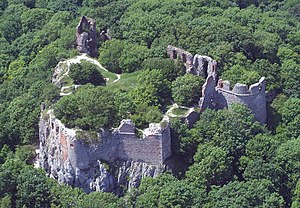Ballenstein Castle
| Ballenstein Castle | ||
|---|---|---|
|
Ballenstein Castle |
||
| Castle type : | Hilltop castle | |
| Conservation status: | ruin | |
| Geographical location | 48 ° 16 '31.6 " N , 17 ° 4' 58.2" E | |
|
|
||
The ruins of the castle Ballstein ( Slovak Hrad Pajštún ) is located in the municipality Borinka (German: Ballstein) near Bratislava in Slovakia . The hilltop castle is located on the western edge of the Little Carpathians at an altitude of 486 m.
history
The exact origins of Ballenstein Castle are unclear. Some historians consider the castle to be identical to the Stupava castle mentioned in documents, as the castle is located above the village of Stupava.
Ballenstein was part of a regional castle system that aimed to defend the north-western border of the Kingdom of Hungary . The original name of the castle was probably the German name Peilenstein . The current Slovak name Pajštún is an alienated version of this German name.
One of the first documented mentions dates back to 1314 in connection with the owner Otto von Telesprun.
It is certain that the castle existed before 1390, when Emperor Siegismund gave it to the Szentgyörgyi family. After its extinction in 1543, the castle was owned by Gašpar Serédy for a while. Around 1550 it came into the possession of Eck Salm from Pressburg ; then it went to Mikuláš Pálffy and after his death to his widow Maria Fugger and his three sons.
Under Pavol Pálffy, the castle was expanded between 1640 and 1645 by the most important Italian architects of the Habsburg monarchy . Filiberto Lucchese directed the expansion, which fundamentally changed the original core of the castle from the 13th century. Around the same time, Stupava Castle was also rebuilt.
architecture
The original medieval castle stood on the upper plateau and only part of the masonry above the eastern cliff has been preserved. The semicircular cannon bastion in the northern part of the fortifications dates from the time of the reconstruction in the 16th century. During the reconstruction of Palffy, the upper plateau to the west was closed off with a palace, in front of which they built a bastion . From this construction phase, the remains of an underground brick cistern have been preserved on the upper plateau of the castle, while only fragments of masonry have been preserved from the southern palace above the rock wall.
The castle buildings have been preserved in fragments around the central courtyard. Partly windows, bay windows, entrances, masonry with relief arches and traces of vaults can be seen. The cantilevers of the former portal above the entrance with late Renaissance masks from 1619 are impressive , which through their diversity give an idea of the architectural demands and the artistic representation of the client.
Ascent
The parking lot in front of the church in Borinka is a good starting point for a hike to the castle. A red hiking trail begins opposite the church. The entire ascent to the castle takes about 30-40 minutes.
Individual evidence
- ↑ hrad Pajštún. Retrieved October 10, 2019 .

